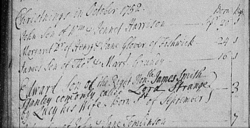Great Britain encompasses England, Wales and Scotland and Northern Ireland. The Republic of Ireland is part of the British Isles but not Great Britain and is dealt with separately. Northern Ireland was created in 1921. People living here may refer to themselves as British or Irish or both, however as most genealogical records date prior to 1921, this is best researched via Irish genealogy. British genealogy here therefore looks at our ancestors who were born, resided and died in England, Wales and Scotland.
Tracing your British ancestors involves looking at common records documenting birth, marriage and death. Other records are used to discover more about them including census returns, parish records, probate records, military documentation, title deeds, manorial records, criminal records and many more. Genealogical records in Britain are largely held in archives.
The type of document that you wish to view may vary in its presentation and current means of access depending on which part of Britain it relates to. Helpfully, Great Britain is one of the leading countries with regards to digitisation and online access.
Research your ancestors on MyHeritage
Records of birth, marriage and deathRecords of birth, marriage and death
Civil registration began in England and Wales in 1837[1] and Scotland in 1855. These officially record a person's birth, marriage and death. The details included on them can vary but the information can help to trace back further generations. For example, birth certificates give the names of both parents unless the child is illegitimate in which case only the mother is normally named. The mother's maiden name is supplied meaning these details can be used to then trace the parents marriage. On a marriage certificate the bride and groom's ages and fathers names are given. These can then potentially be used to trace their birth records. These are also sometimes referred to as vital records.

Prior to civil registration, records of baptism, marriage and burial were kept by the relevant church. For example, in England these were written by the clergy of the Church of England.[2] These records can date back to the 16th century. These registers are known as parish registers in England and Wales and old parochial registers in Scotland. Older entries tend to give little detail; often just the name of the person and the date of the event. Later recordings give more information including the parents names of a child being baptised and names of witnesses at marriages.
You can view relevant records in the United Kingdom - Birth, Marriage & Death section on MyHeritage. You may alternatively discover dates of birth, marriage and death in other records. This could include passports, military documentation, newspaper articles and manorial court records.
Census recordsCensus records

When you have researched your tree using records of civil registration, the natural next step with regards to British genealogy is to find your ancestors in the census returns. These are currently available to view each ten year submission from 1841 to 1921. Traditionally, it is best to work backwards. First find your ancestors in the 1921 census, then 1911 and work backwards until 1841. This can help to track changing family patterns and can help avoid diving into researching the wrong family in an earlier period.
The next census of Scotland to be released will be the 1931 returns. Unfortunately the returns for England and Wales for 1931 were destroyed by fire, including both the individual returns and the enumeration books. There was no census taken in 1941 due to World War II, meaning the next census for England and Wales to be released will be the 1951 census. Many people choose to peruse the 1939 Register of England and Wales which can help to fill in some gaps. Transcripts are available on MyHeritage in their 1939 Register of England & Wales collection.
Further British recordsFurther British records
There are a huge range of other sources that can be consulted to discover more about your British genealogy. These include:
- Alumni and educational records
- Apprenticeship and occupational records
- Criminal, civil and ecclesiastical court records
- Divorce records
- Electoral registers and poll books
- Heraldry
- Hospital records
- Immigration and emigration records
- Inquest records
- Manorial records
- Maps (for example tithe maps, enclosure maps, Lloyd George Domesday survey and Ordnance Survey maps)
- Memorial inscriptions
- Military records
- Newspapers and magazines
- Nonconformist records
- Parish records including workhouse registers, bastardy records and settlement documentation
- Photographs
- Tax lists
- Title deeds
- Wills
The above list is not exhaustive. To gain the fullest picture of your ancestor's life and ensure you are tracing the correct line, as many records as possible should be consulted. As well as telling you names and dates, the records in the above list will help you understand more about who your ancestor was as a person including any criminal records, their educational background, their religious beliefs, their military service and what property they owner amongst many other details.
You can find records in the United Kingdom - Collection Catalog on MyHeritage.
See alsoSee also
Explore more about British genealogyExplore more about British genealogy
- United Kingdom - Collection Catalog at MyHeritage
- How to Research Your Ethnicity with Genealogy on the MyHeritage Genealogy Hub
- British Genealogy Online: The Top English & Welsh Family History Websites at Legacy Family Tree Webinars
- British and Irish research: the differences at Legacy Family Tree Webinars
- The Quest for your English Ancestors at Legacy Family Tree Webinars
- Research guides at The National Archives website
References
- ↑ The General Register Office celebrates 175 years of civil registration. GOV.UK
- ↑ Parish Registers search guide. The London Archives

